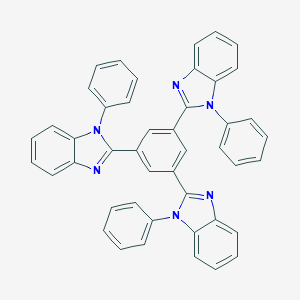For the first time, scientists have proposed the concept of an iron protein drug carrier
-
Last Update: 2020-12-29
-
Source: Internet
-
Author: User
Search more information of high quality chemicals, good prices and reliable suppliers, visit
www.echemi.com
known as "biological missiles" for cancer targeting treatment, the core purpose is to accurately snipe cancer cells, while avoiding damage to normal cells.
delivers the drug precisely to the carrier of cancer cells, like the missile's guidance system and power unit. Humans have a never-ending quest for larger, more efficient, and more biologically friendly targeted drug carriers.
, the Chinese Academy of Sciences Institute of Biophysics, the first time the concept of ferrine drug carriers, related papers published in the Journal of Controlled Release.in recent decades, humans have developed a variety of drug delivery vectors, common types including nano-carriers and antibody drug companies (ADCs). However, traditional nano-carriers often have poor compatible with organisms, poor delivery efficiency and strong toxicity, and ADC has some disadvantages in terms of drug carrying capacity and stability.
What scientists would prefer to find is a drug vector that comes from a protein that is naturally present in the organism, is not toxic, degrades easily, and is not prone to excret reactions; it does not "hang" the drug on the surface like the ADC does; it wraps the drug around it, which has a greater load and is more stable and safe; and it does not require additional "positioning systems" to automatically identify cancer cells, greatly reducing the difficulty and cost of production.
, a protein commonly found in living things, surprisingly has all of these traits.
as the name suggests, ferrine is a protein that stores iron and plays a key role in the body's iron balance and cell antioxidant process. Fan Kelong, one of the paper's co-authors and a researcher at the Institute of Biophysics, told the China Science Journal that ferritin particles are hollow globular bodies with an outer diameter of 12 nanometers and an internal diameter of 8 nanometers, which can be increased by genetic and chemical modifications on the outer surface, while the hollow inner cavity can be used to encapsulate the drug.
Ferrin drug vectors recognize and bind to a membrane protein on the cell surface called translatin protein litrans (TfR1), mediated by TfR1, into tumor cells, rich in lysosomes and release the chemotherapy drugs they carry.
tumor cells are too strong for growth and proliferation, the demand for iron ions is much greater than that of normal cells. As a result, TfR1 expression on the surface of tumor cells is often much higher than in ordinary cells. Ferrine enters the cell only if the expression of TfR1 is above a threshold. Therefore, ferrine can selectively collect to tumor cells and release loaded drugs in the acidic microenviron environment unique to tumor cells.
these properties give ferrine an impressive tumor-targeted potential.2012, the team published its results in Nature-Nanotechnology, announcing that bionics had synthesized a new type of ferrite nanoparticle.
" modified ferrine nanoparticles are 'unlike God-like' to natural proteins. Yan Xiyun, a member of the Chinese Academy of Sciences and a researcher at the Institute of Biophysics, told the China Science Daily that the shell of natural ferrine is a light-heavy chain mix, of which only heavy chains can identify tumors. So the researchers created more efficient pure heavy-chain ferrooprotein nanoparticles.
After, in 2014 and 2016, the team replaced the core of ferrine with the chemotherapy drug amycin, which can be accurately delivered to the tumor site for therapeutic purposes, and the latter, which can visualize tumor cells through MRI to achieve the effect of tumor diagnosis in the body. The two papers were published in the Proceedings of the National Academy of Sciences and ACS nano.
animal experiments have shown that the treatment of ferrine can effectively inhibit the growth of colon cancer, breast cancer and melanoma, while also effectively reducing the side effects of cardiac toxicity caused by amycin.
a study published in ACS Nano in 2018, researchers found for the first time that ferrine can also cross the well-known "blood-brain barrier."
blood-brain barrier is a natural barrier that maintains the stability of the central nervous system and protects brain tissue. But the blood-brain barrier protects the nervous system while shielding most drugs. This leaves the central nervous system in a difficult position to use.
TfR1 is like a "ferryman" that can help large molecule drugs pass through the blood-brain barrier. But most of the antibodies it can "ferry" will be degraded by the lysosomes of the endostropheric cells on the way through the blood-brain barrier, and will eventually fail to reach the lesions.
the beauty of ferrine is that it passes through the blood-brain barrier through the transocellular swallowing of endoblasts without being blocked in lysosomes. In mice with malignant brain tumors, ferrine not only successfully crossed the blood-brain barrier, but also specifically rich in tumor areas, by releasing drugs to inhibit the growth of malignant brain tumors, normal brain tissue was not damaged.
" these phenomena suggest that ferrine is expected to provide a potential nanoprotein carrier platform for a variety of central nervous system diseases. Van Kroen said. decades, the team has been conducting in-depth research on this nanoscale "small ball", on the one hand, constantly excavating the hidden magical properties of ferroglobin, on the other hand, it is constantly transforming ferrine to make it more responsive to human needs.
" earliest ferrin particles can only carry 35 drug molecules, and now they can carry 400. "This is important because the size of the capacity directly determines whether it can become a practical drug carrier. "
called ferrin a surprising "magic particle", " he said with a laugh. "Humans have been studying ferrine for nearly a century. It was only in the last decade that we discovered that ferrin may be a gift from nature. As a protein naturally present in the human body, ferrine has a variety of unique properties, but also has a delicate tumor targeting and excellent biological compatibility. We look forward to turning ferrrotein into an ideal cancer-targeted drug vector and pushing it further into the clinic, bringing new hope to the human fight against cancer. James McLeod,
's former vice president of clinical research and development at Novart, Synthesia and Mercedon, who was not involved in the study, told China Science: "Anti-tumor drugs are often the most toxic drugs, and ferrne provides a more selective approach to the delivery of these harmful drugs, making it possible to treat treatments that are more effective and have fewer side effects."
He added: "Although we have limited understanding of the potential of ferrite in clinical applications, its automatic search for tumor properties is not only expected to improve the effectiveness of some traditional chemotherapy drugs, but more importantly, some drugs that have not previously been able to reach tumors safely at effective doses, with the help of ferrite delivery, is also expected to become worthy of development of new drugs." "
the current ferrine drug carrier is about to enter the transformation stage of results, and then will carry out pilot amplification production and production process amplification and optimization. (Source: Li Chenyang, China Science Journal)
related paper information:
This article is an English version of an article which is originally in the Chinese language on echemi.com and is provided for information purposes only.
This website makes no representation or warranty of any kind, either expressed or implied, as to the accuracy, completeness ownership or reliability of
the article or any translations thereof. If you have any concerns or complaints relating to the article, please send an email, providing a detailed
description of the concern or complaint, to
service@echemi.com. A staff member will contact you within 5 working days. Once verified, infringing content
will be removed immediately.







